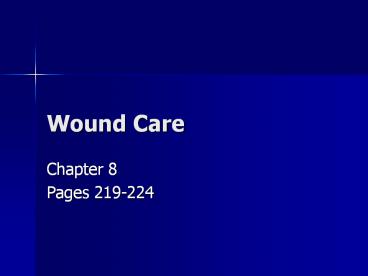Wound Care PowerPoint PPT Presentation
1 / 22
Title: Wound Care
1
Wound Care
- Chapter 8
- Pages 219-224
2
Caring for Skin Wounds
- Skin wounds are extremely common in sports
- Soft pliable nature of skin makes it susceptible
to injury - Numerous mechanical forces can result in trauma
- Friction, scrapping, pressure, tearing, cutting
and penetration
3
Types of wounds
- Abrasions
- Skin scraped against rough surface
- Top layer of skin wears away exposing numerous
capillaries - Often involves exposure to dirt and foreign
materials increased risk for infection
4
Abrasions
5
Types of wounds
- Laceration
- Sharp or pointed object tears tissues results
in wound with jagged edges - May also result in tissue avulsion
6
Laceration
7
Laceration
8
Laceration
9
Types of wounds
- Incision
- Wounds with smooth edges
10
Incisions
11
Types of wounds
- Puncture wounds
- Can easily occur during activity and can be fatal
- Penetration of tissue can result in introduction
of tetanus bacillus to bloodstream - All severe lacerations and puncture wounds should
be referred to a physician
12
Puncture Wounds
13
Types of wounds
- Avulsion wounds
- Skin is torn from body major bleeding
- Place avulsed tissue in moist gauze (saline),
plastic bag and immerse in cold water - Take to hospital for reattachment
14
Avulsion
15
Immediate Care
- Should be cared for immediately
- All wounds should be treated as though they have
been contaminated with microorganisms - To minimize infection, clean wound with copious
amounts of soap, water, and sterile solution - Avoid hydrogen peroxide and bacterial solutions
initially
16
Immediate Care
- Dressing
- Sterile dressing should be applied to keep wound
clean - Occlusive dressings are extremely effective in
minimizing scarring - Antibacterial ointments are effective in limiting
bacterial growth and preventing wound from
sticking to dressing - Utilization of hydrogen peroxide can occur
several times daily before reapplication of
ointment
17
Immediate Care
- Sutures may be necessary
- Deep lacerations, incisions, and occasionally
punctures will require some form of manual
closure - Decision should be made by a physician
- Sutures should be used within 12 hours
- Area of injury and limitations of blood supply
for healing will determine materials used for
closure - Physician may decide wound does not require
sutures and utilize steri-strips or butterfly
bandages
18
Use of Sutures
19
Signs of Wound Infection
- Same as those for inflammation
- Pain
- Heat
- Redness
- Swelling
- Disordered function
- Pus may form due to accumulation of WBCs
- Fever may develop as immune system fights
bacterial infection
20
(No Transcript)
21
Tetanus
- Bacterial infection that may cause fever and
convulsions and possibly tonic skeletal muscle
spasm for non-immunized athletes - Tetanus bacillus enters wound as spore and acts
on motor end plate of CNS - Following childhood vaccination, boosters should
be supplied once ever 10 years - If not immunized, athlete should receive tetanus
immune globulin (Heper-Tet) immediately following
skin wound
22
(No Transcript)

